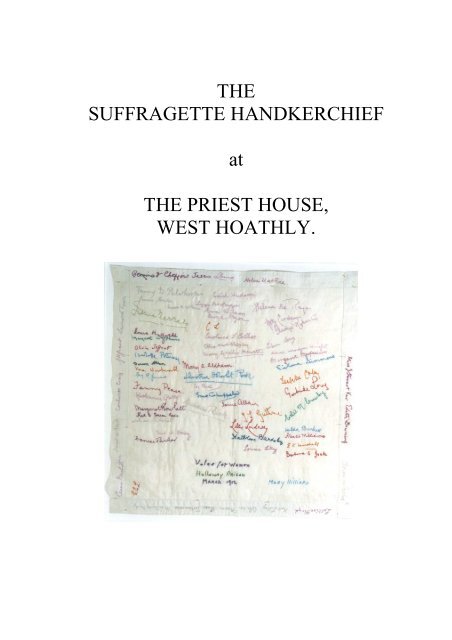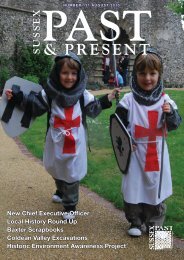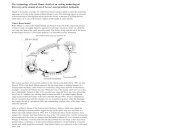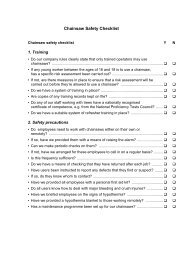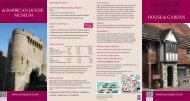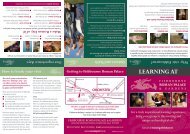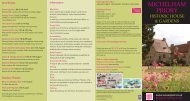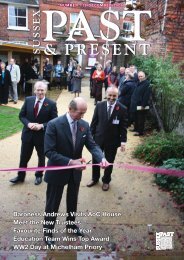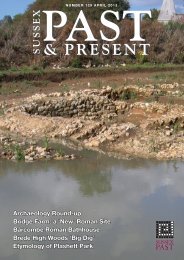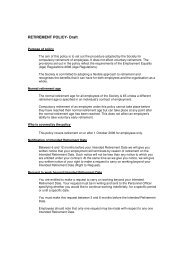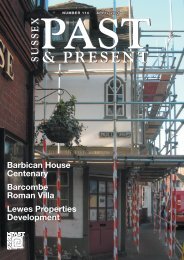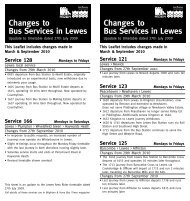The suffragette handkerchief - Sussex Archaeological Society
The suffragette handkerchief - Sussex Archaeological Society
The suffragette handkerchief - Sussex Archaeological Society
Create successful ePaper yourself
Turn your PDF publications into a flip-book with our unique Google optimized e-Paper software.
THE<br />
SUFFRAGETTE HANDKERCHIEF<br />
at<br />
THE PRIEST HOUSE,<br />
WEST HOATHLY.
THE PRIEST HOUSE, WEST HOATHLY.<br />
SUFFRAGETTE HANDKERCHIEF.<br />
HOLLOWAY PRISON, MARCH 1912.<br />
March 1912 saw the second wave of window-smashing demonstrations<br />
organised in London by the Women’s Social & Political Union (WSPU), when the<br />
militant campaign for women’s suffrage was at its peak. After the earlier<br />
demonstrations of November 1911, 223 women had been arrested for breaking the<br />
windows of shops in <strong>The</strong> Strand & of Government buildings in Whitehall.<br />
<strong>The</strong> March demonstrations were larger & better organised & timed to coincide<br />
with the discussion in Parliament of the Conciliation Bill that would have given the<br />
vote to about one million, mainly single, women. Militant feeling had been growing in<br />
the country & it became apparent that peaceful protests could never be successful.<br />
On the evening of Friday March 1 st , & again on the following Monday, WSPU<br />
supporters gathered in the shopping streets of the West End, Knightsbridge,<br />
Kensington & Chelsea. <strong>The</strong>y were armed with hammers or stones & at a pre-arranged<br />
time they began smashing the windows of shops & offices. Once again over 200<br />
women were arrested.<br />
Following the demonstrations the leaders of the WSPU, Emmeline Pankhurst &<br />
Mr. & Mrs. Pethick-Lawrence were arrested & sentenced to nine months in prison,<br />
although Christabel Pankhurst escaped to Paris where she remained in exile until the<br />
First World War. <strong>The</strong> Government granted them special privileges, which they<br />
refused to accept but for the majority of prisoners there were no such concessions.<br />
Demonstrators were, on average, sentenced to two months imprisonment for<br />
refusing to be fined or bound over to keep the peace, or were sentenced directly to two<br />
to six months in prison. Holloway was soon full & women were sent to Aylesbury or<br />
Winsom Green, Birmingham. Nevertheless the prisons were badly over-crowded &<br />
the women were denied the status of political prisoners, which they sought. Hunger<br />
strikes were started to reinforce the women’s demands & many were brutally forcibly<br />
fed. By the end of June most of the hunger strikers were released on medical grounds.<br />
<strong>The</strong>y claimed a victory but in 1913 the Home Secretary, McKenna, introduced the<br />
“Cat & Mouse” Act, which allowed the police to re-arrest convicted hunger strikers<br />
once they had recovered.<br />
<strong>The</strong> <strong>handkerchief</strong>, which was probably embroidered in one of the women’s<br />
limited exercise periods, bears sixty-six signatures & two sets of initials. Most of the<br />
women who signed were participants in the March demonstrations. A few were well<br />
known as militant members of the WSPU & had been imprisoned many times but the<br />
majority were rank & file members of the organisation. <strong>The</strong>y came from all parts of<br />
the country & from a variety of class backgrounds & age groups simply to support the<br />
“Cause”.<br />
2
<strong>The</strong> following is a list of the women who signed the <strong>handkerchief</strong>, with the<br />
limited information we have on them:<br />
Mary A. Aldham.<br />
She had been imprisoned after the November 1911 window-smashing<br />
demonstrations & was sentenced to six months after the March protest. She took part<br />
in the hunger strike & was released at the end of June without being forcibly fed. She<br />
was one of the two grandmothers whose names appear on the <strong>handkerchief</strong>.<br />
Janie Allan.<br />
She was imprisoned in November & sentenced to four months in March. Her<br />
trial was notable for her speech comparing the apparent tolerance of child abuse, the<br />
white slave traffic (kidnapping of young girls who were forced into prostitution) & the<br />
exploitation of women at work, with the outcry over breaking shop windows. She was<br />
a member of a wealthy Socialist shipping family from Glasgow, where 10,500 people<br />
signed a petition protesting at her imprisonment. In May she barricaded herself in her<br />
cell & later joined the hunger strike, which lead to her being forcibly fed. She<br />
continued with her militant actions after her release & in 1914 she became famous for<br />
firing a blank shot at a policeman trying to arrest Mrs. Pankhurst.<br />
Doreen Allen.<br />
Sentenced to four months she was forcibly fed after joining the hunger strike. To<br />
pass the time a scene from Shakespeare’s “<strong>The</strong> Merchant of Venice” was performed<br />
by the prisoners & she took the part of Narissa.<br />
Kathleen Bardsley.<br />
No information available. She may have used a false name when arrested. This<br />
was often done to protect a husband or family.<br />
Janet Boyd.<br />
<strong>The</strong> second grandmother on the <strong>handkerchief</strong>, she was imprisoned in November<br />
& sentenced to six months in March. She went on hunger strike but released at the end<br />
of June without being forcibly fed.<br />
Hilda Burkitt.<br />
She was a WSPU organiser in Birmingham & had been arrested many times<br />
before being sentenced to four months in March. At her trial she said that she had<br />
done nothing malicious & refused to be bound over, saying that she would consider it<br />
a disgrace to womanhood. She went on hunger strike & was released before the end of<br />
her sentence. She played the part of Shylock in “<strong>The</strong> Merchant of Venice”. In 1914<br />
she was imprisoned again for setting fire to a house & some haystacks in Suffolk.<br />
Eileen Casey.<br />
Sentenced to four months, she was forcibly fed after going on hunger strike. She<br />
was arrested on at least two other occasions; once in Bradford, when she was<br />
sentenced to nine months but escaped dressed in men’s clothing & again in<br />
Nottingham when she was sentenced to 15 months after being found in possession of<br />
explosives.<br />
Isabella Casey.<br />
She was arrested in March but no further information is available.<br />
3
Kate E. Teresa Cardro.<br />
She was awarded the WSPU medal for taking part in the 1912 hunger strike but<br />
little else is known of her.<br />
Grace Chappelow.<br />
From Chelmsford in Essex, she had been arrested in November & was<br />
imprisoned again, for four months in March.<br />
Georgina J. Cheffins.<br />
Sentenced to four months. At her trial she said that she was a Suffragist by<br />
conviction, because, after living & working among the very poor for more than twenty<br />
years, she had come to the conclusion that all efforts to improve their conditions were<br />
futile without the benefit of the franchise. She supported the WSPU because she felt<br />
that their militant methods gave the best chance of success. She joined the hunger<br />
strike & was forcibly fed.<br />
Constance J. Collier.<br />
She was Hon. Secretary of the Hampstead WSPU & was sentenced to four<br />
months.<br />
Constance Craig.<br />
She had been imprisoned in November & was sentenced to two months hard<br />
labour in March. She later wrote of her first spell in prison; “I was sentenced to three<br />
weeks but there were so many of us that the authorities got muddled, & I served only<br />
three days – someone else did my three weeks”.<br />
Ethel M. Crawby.<br />
No information available.<br />
Nelly Crocker.<br />
One of the organisers of the Nottingham branch of the WSPU she was sentenced<br />
to four months in prison for attacking a post office in Sloane Square. At her trial she<br />
said that she was there as a result of the brutality shown against women on “Black<br />
Friday” (when women marching on Parliament had been attacked by the police). She<br />
also wanted to protest against the vindictive sentences given to WSPU supporters.<br />
Alice Davies.<br />
Forty-two years old & from Liverpool she was sentenced to three months. She<br />
said at her trial that women were determined to fight for the same human rights<br />
enjoyed by men. <strong>The</strong>y were tired of being treated as aliens & would continue their<br />
struggle until they had reached their objective.<br />
Edith Downing.<br />
She had been imprisoned in November & was sentenced to six months in March.<br />
At her trial she told the jury that she regretted that peaceable & law-abiding women<br />
had been forced to do these things. She referred to the brutality of “Black Friday”,<br />
when she had almost lost her life & to the taunts of cabinet ministers over the<br />
women’s previous mild methods. She said that women were prepared to die in this<br />
“agitation”. She joined the hunger strike & was forcibly fed before being released<br />
early in June.<br />
4
Emma Fowler.<br />
She was arrested in March but no further information is available.<br />
Lettice Floyd (1865-1934).<br />
Sentenced to two months hard labour. She came originally from Berkswell, near<br />
Solihull where she was a nurse in a children’s hospital. She later wrote of this<br />
experience; “I was there some years, but as most of the cases seemed to be due to bad<br />
housing, bad feeding or immorality, it was not entirely satisfactory work, & it did not<br />
go to the root of the matter”. With her sister, Mary, she set up a local branch of the<br />
Birmingham & District Suffrage <strong>Society</strong> but after the first militant actions of the<br />
Suffragettes this was dissolved & she left the hospital to work for the WSPU. In 1912<br />
she was Hon. Secretary of the Halifax & Huddersfield branch. She was arrested<br />
several times, in London, Leeds, Hull & Cardiff.<br />
Katherine Gatty.<br />
A member of the Women’s Freedom League & a friend of Emily Wilding<br />
Davison, she was imprisoned in November & was given a six-month sentence in<br />
March. At her trial she said that men were allowed to break women’s hearts & homes<br />
without punishment & that for breaking £42 worth of glass she was being sentenced<br />
to four months more than an Edinburgh man who had broken his wife’s skull. In her<br />
opinion property was worth more in the eyes of the law than the person. When in<br />
prison for the first time she had seen the misery & poverty &, even though she was<br />
peaceable by nature, she would gladly break the law if by doing so she could obtain<br />
for women some voice in the making of it. Although Suffragettes were normally<br />
segregated from other prisoners this was not always the case & she was initially sent<br />
to Holloway’s E block, which “was ghastly! <strong>The</strong> lavatory accommodation was<br />
absolutely inadequate. <strong>The</strong> whole block was infested with mice & co. – there was no<br />
heating apparatus at all”. She had the privilege of visits withdrawn for refusing to<br />
work in prison &, after going on hunger strike, was forcibly fed thirteen times. She<br />
was released early, in June, in a very weak condition. She was forty-two years old.<br />
G. H. Grant.<br />
She was imprisoned in November & sentenced to two months hard labour in<br />
March.<br />
Alice Green.<br />
Imprisoned in November & sentenced to four months in March. She refused to<br />
be bound over, saying; “Let me tell you what I have gone through lately on behalf of<br />
this cause. I have given up my home, my husband & my child, & I shall not go back<br />
until women get the vote”. She went on hunger strike & by the middle of May was<br />
being forcibly fed through a nasal tube. She was eventually released at the end of<br />
June. She was forty years of age.<br />
J. L. Guthrie.<br />
No information available.<br />
Louise Hargeld.<br />
No information available.<br />
Mary Granley Hewitt.<br />
Sentenced to four months.<br />
5
Mary Hilliard.<br />
She was sentenced to two months hard labour & would appear to have written<br />
“Votes for Women” on the <strong>handkerchief</strong>. She may have organised the project & kept<br />
the finished article.<br />
Edith Hudson.<br />
She was a forty-year old hospital nurse from Edinburgh & secretary of the<br />
Edinburgh & East Scotland branch of the WSPU. She was imprisoned many times,<br />
sometimes under her alias, Mary Brown. She was sentenced to two months but was<br />
released in June, after joining the hunger strike & being forcibly fed, on payment of a<br />
£3 fine by her family. She told the authorities that “it was just like her mother to be so<br />
determined”. In April 1913 she attempted to set fire to a stand at Kelso race course &<br />
also took part in an attack on the Wallace Monument in Stirling.<br />
Olivia Jeffcott.<br />
She was sentenced to two months hard labour.<br />
Barbara S. Jocke.<br />
No information available.<br />
May R. Jones.<br />
From Birmingham, she had been imprisoned in November 1911 but her sentence<br />
in March is not known. She went on hunger strike in May & was forcibly fed with a<br />
nasal tube. She seems to have been released at the end of May.<br />
Alice J. Stewart Ker (1853-1943).<br />
A fifty-eight year old doctor born in Banff in Scotland, Alice Ker studied<br />
medicine in Dublin & Berne before working as a surgeon at the Children’s Hospital in<br />
Birmingham. She moved to Birkenhead & became Honorary Medical Officer to the<br />
Wirral Hospital for Sick Children; also becoming involved in the Temperance<br />
Movement & the <strong>Society</strong> for the Prevention of Cruelty to Animals. In the 1890’s she<br />
became active in the Birkenhead Women’s Suffrage <strong>Society</strong>. She was sentenced to<br />
three months in prison for breaking windows in Harrods. At her trial she said that as a<br />
doctor in practice, a lecturer in T.B., a mother of daughters & President of the<br />
Women’s <strong>Society</strong> of Liverpool she felt that it was her duty to do all that she could to<br />
bring about reform. She quoted cabinet ministers advising women to use force &<br />
stated that because of the just reasons for her actions she was not, morally, guilty of<br />
any offence.<br />
C. L. & C. E. L.<br />
<strong>The</strong> two sets of initials are a bit of a mystery. Lady Constance Lytton was well<br />
known as a Suffragette & one of the leaders of the WSPU, but they cannot be her<br />
initials as she was not in prison at this time. C. L. could be Catherine Lane, who was<br />
arrested on March 1 st & was eventually bound over & released in Early April.<br />
C. E. L., in the bottom left –hand corner, may simply be the initials of the owner of<br />
the <strong>handkerchief</strong>.<br />
Jessie Laing.<br />
She was sentenced to two months hard labour.<br />
6
Kate Lilley & Louise Lilley.<br />
<strong>The</strong>y were sisters, members of the WSPU in Clacton-on-Sea & the daughters of<br />
a “well- known Essex gentleman”. <strong>The</strong>y were both sentenced to two months hard<br />
labour.<br />
Lillie Lindesay.<br />
She was sentenced to two months.<br />
Gertrude Lowy.<br />
Sentenced to two months hard labour.<br />
Margaret Macfarlane.<br />
She was the Hon. Secretary of the WSPU in Dundee & East Fife. She had been<br />
imprisoned in November & was sentenced to four months in March. At her trial she<br />
said that all her life she had been a reformer & had found that the only argument<br />
listened to by those in power was inconvenience. She refused to be bound over,<br />
saying; “I prefer to agitate in a way that will be successful. If it means six months or<br />
six years, I prefer to go on”. She went on hunger strike & by the middle of May she<br />
was being forcibly fed by nasal tube. After her release at the end of June she described<br />
being forcibly fed by mouth:<br />
“I was lifted into a chair & tied with a strong sheet to the back<br />
of the chair. As far as I can remember, my arms were held on<br />
each side on the arms of the chair. <strong>The</strong>re was a wardress with a<br />
feeding cup & one behind my chair, making a gag for the mouth<br />
with her fingers. Another held my knees. I told them that I<br />
would not swallow a drop of the gruel voluntarily. When they<br />
found that I did not retain any of the food, the one who was<br />
gagging me egged the others on to tickle me, to hold my nose to<br />
make me swallow, & to grip me on the throat, which to me is<br />
the most cruel. <strong>The</strong> pressing of the throat to make one swallow<br />
gives a fearful feeling of suffocation. When they got my feet up, my head<br />
was hanging right over the back of the chair, which added to the choking<br />
sensation”.<br />
Helen MacRae.<br />
She came from Edenbridge, in Kent. She was a member of the NUWSS but left<br />
to join the WSPU & became a member of the East Grinstead Suffrage <strong>Society</strong>. On<br />
July 8 th 1911 she helped to organise the first WSPU meeting in the town at the<br />
Queen’s Hall. Soon afterwards she was arrested for breaking windows in Whitehall &<br />
was sentenced to four months in prison. In March she was sentenced to another four<br />
months & was forcibly fed after going on hunger strike.<br />
Lizzie McKenzie.<br />
She was sentenced to two months. She said at her trial; “I do not wish to say<br />
anything at all. I only wish to say that whatever I did, I did as a protest against the<br />
Government’s action”.<br />
Frances M. McPhun (1880-1940) & Margaret McPhun (1876-1960).<br />
<strong>The</strong> McPhuns were sisters & the daughters of a Glasgow J. P., who both gained<br />
M. A.’s at Glasgow University. Both were very active in the WSPU. Frances was the<br />
Organising Secretary of the Glasgow & West Scotland branch & Margaret acted as<br />
7
Press Secretary for Scotland. <strong>The</strong>y were both sentenced to two<br />
months imprisonment & took part in the April hunger strikes but<br />
there is no mention of them in the reports of arrests & trials in<br />
“Votes for Women” (the WSPU newspaper). This suggests that<br />
they were arrested under false names, although they both received<br />
the WSPU hunger strike medal.<br />
Margaret McPhun<br />
E. K. Marshall.<br />
She had been arrested in November & was sentenced to three months in March.<br />
Lillias Mitchell.<br />
Aged twenty-seven, & described as “independent”, she came from Aberdeen &<br />
was the organiser of the WSPU in Edinburgh & the East of Scotland. She was known<br />
for replacing the flags on the greens of Balmoral Golf Course with new ones in<br />
WSPU colours. Sentenced to four months in March, she went on hunger strike but<br />
was released at the end of June without being forcibly fed. In 1913 she became WSPU<br />
organiser of the Newcastle & District branch.<br />
Anne Myer.<br />
She came from Liverpool & was one of a group from the city who travelled to<br />
London especially for the March demonstrations. She was sentenced to two months.<br />
Cassie Nesbit.<br />
She was sentenced to two months.<br />
Fanny D. Palethorpe.<br />
Although she was not a member of the WSPU, or any other suffrage society, she<br />
was sentenced to four months in prison. She was thirty-nine years of age & came from<br />
Ainsdale in Lancashire. At her trial she said that, although she had always worked on<br />
constitutional lines, she had come to realise that peaceful protests would be of no avail<br />
with the present Government.<br />
Frances Parker (1875-1924).<br />
A niece of Lord Kitchener, she was the WSPU organiser for Glasgow & the<br />
West of Scotland. She said at her trial; “If I had thrown a stone as a striker, or even as<br />
a man who is intoxicated, I suppose I should have received a very light sentence; for I<br />
have noticed that men in Swansea, when they were held up for rioting, got a fortnights<br />
imprisonment, & the ringleader of them got only six weeks imprisonment. Of course,<br />
I admit that the whole difference is the difference of motive, but I think the long<br />
sentences in our case prove that the motive is recognised, & I contend that if you<br />
recognise the motive you should also recognise the provocation”. She was sentenced<br />
to four months imprisonment. In 1914 she was arrested & imprisoned (under her alias,<br />
Janet Arthur) for trying to blow up Burns Cottage in Alloway.<br />
Fanny Pease.<br />
Sentenced to two months imprisonment.<br />
Isabella Potbury.<br />
She was a student who had been imprisoned in November & was sentenced to<br />
another six months in March. She was released early, at the end of June, after joining<br />
the hunger strike & being forcibly fed.<br />
8
Zoe Proctor.<br />
Sentenced to two months imprisonment. Like many of the women she came<br />
from an affluent background & initially had trouble adapting to prison routine. She<br />
expected her bed to be made for her, much to the amusement of the other prisoners.<br />
M. Renny.<br />
Sentenced to two months imprisonment.<br />
Helena de Reya.<br />
Aged thirty-one, she was one of the group from Liverpool. At her trial she said<br />
that she did not consider that she was morally or legally guilty. <strong>The</strong> Government, &<br />
the Government alone, held it in their power to stop any further scenes of disorder.<br />
She was sentenced to four months.<br />
Gladys Roberts.<br />
A former solicitor’s clerk, she was the joint organiser, with Nelly Crocker, of the<br />
Nottingham branch of the WSPU. She had been imprisoned in 1909 & 1911 for<br />
breaking Post Office windows. In March 1912 she was sentenced to four months.<br />
Dorothea Herlet Rock & Madeleine Rock.<br />
Both had been imprisoned in November & both were sentenced to two months<br />
in March.<br />
Margaret Rowlatt.<br />
She had been imprisoned in November & was sentenced to six months in March.<br />
She went on hunger strike & was released, without being forcibly fed, in June.<br />
M. du Santay Newby.<br />
She was the Hon. Secretary & Treasurer of the WSPU in Ilfracombe &<br />
Barnstable. She was probably arrested under a false name as there is no record of her<br />
being arrested or on trial in March 1912.<br />
Alice Maud Shipley.<br />
She had been imprisoned in November, but at her trial in March she said; “More<br />
than half my life I have been doing what lies in me to help the poor & unfortunate. As<br />
a member of a Vigilance <strong>Society</strong>, & as a worker in connection with other societies, I<br />
know the condition of our women & girls, & the dangers that lie about them & that<br />
they have no power to protect themselves; & that knowledge has made me take up the<br />
attitude I have today. I feel our case is a most urgent one, & I feel that only a woman<br />
can understand a woman’s needs, that women suffer for the want & care of men, &<br />
that their salvation lies in looking after their own needs & in demanding the vote”.<br />
She refused to be bound over & was given a four month sentence. She went on hunger<br />
strike & was forcibly fed before being released at the end of June. She was forty-two<br />
years old.<br />
Victoria Simmons (1889-1992).<br />
Born in Bristol in 1889 & one of twelve children, she left school at fourteen<br />
because her father believed daughters should not receive the same education as sons<br />
& spent many years campaigning for equality in education. She was sentenced to two<br />
months imprisonment in 1912 for breaking a window at the War Office in Whitehall,<br />
the police found eight more stones in her pockets.<br />
9
Janie Terrero (1858-1944).<br />
She was the Hon. Secretary of the Pinner WSPU & was sentenced to four<br />
months. She later wrote an account of her prison experiences of 1912; “I was in close<br />
confinement for twelve days, was in two hunger strikes & was forcibly fed in April &<br />
again in June. To those who intend to be actively militant, I want to say this; you<br />
cannot imagine how strong you feel in prison. <strong>The</strong> Government may take your liberty<br />
from you & lock you up, but they cannot imprison your spirit. <strong>The</strong> only one thing the<br />
Government really fears is the hunger strike. <strong>The</strong>y fear it not because of our pain &<br />
suffering, but because it damages their majorities. How strong that weapon made us<br />
feel. If they had only dared, they would have put us in a lethal chamber. Some people<br />
wonder at the courage of our women, but I believe physical courage is a common<br />
human attribute, & I do not see why women should possess it in a lesser degree than<br />
men”.<br />
Grace Tollamache.<br />
She joined the WSPU in 1910 & was, with her sister, the joint Hon. Secretary of<br />
the Bath branch. In 1911 she took part in a Census boycott (on the night of the census<br />
count a number of women stayed away from home to protest at their lack of political<br />
rights). After the March demonstration she was sentenced to two months. In 1914 she<br />
was arrested after smashing a window at Buckingham Palace in the middle of a<br />
banquet but the King refused to prosecute.<br />
Leanora Tyson.<br />
She was sentenced to two months. She was the secretary of the<br />
Streatham branch of the WSPU & had also been organising secretary<br />
of the Lambeth Branch. In February 1912 she had been on a speaking<br />
tour of Germany on behalf of the organisation. Her mother & sister<br />
were also active WSPU members & were imprisoned in 1912.<br />
Vera Wentworth.<br />
Possibly one of the best known of the women named on the <strong>handkerchief</strong>, she<br />
wrote plays for the Actresses Franchise League & took part in some of the suffrage<br />
movements most militant actions; she was one of the protestors who interrupted the<br />
holiday of Prime Minister Herbert Asquith by breaking windows, shouting at him in<br />
church & decorating gardens with “Votes for Women” badges. At her trial in 1912<br />
she said that smashing windows was very unpleasant. <strong>The</strong>y would not have done it<br />
without the incitement of Mr. Hobhouse (he was M. P. for Bristol & had unfavourably<br />
compared the non-violent methods of the women with previous successful, but<br />
violent, suffrage movements) & as long as the Liberal Government behaved like this<br />
they would continue to do it. She would have done a great deal more, had she not<br />
been restrained by the leaders, she would do the same thing again & possibly worse.<br />
<strong>The</strong> prosecution pointed out that she had been convicted in 1909, 1910 & November<br />
1911, & she was sentenced to six months. She went on hunger strike & was forcibly<br />
fed by nasal tube before being released at the end of June.<br />
Frances Williams.<br />
She was sentenced to four months imprisonment. At her trial she said that it was<br />
a political protest against injustice, made in her old age, & not with any malice. She<br />
went on hunger strike & was released in June without being forcibly fed.<br />
10
Eva Wilson.<br />
Sentenced to two months imprisonment.<br />
Alice Morgan Wright (1881-1975).<br />
She was an American sculptress & member of the National Association of<br />
Women Painters & Sculptors. She also campaigned against animal cruelty but little is<br />
known of her involvement with women’s suffrage in this country.<br />
Of the 66 women whose full names appear on the <strong>handkerchief</strong>, 61 are known to<br />
have been arrested on the window-smashing demonstrations; 25 are known to have<br />
received sentences of two months, 3 of three months, 18 of four months & 8 of six<br />
months. Sixteen held positions in local branches of the WSPU in 1912 & 18 had<br />
previously been in prison for activities linked to the suffrage movement; at least four<br />
are known to have been arrested again in later years. Twenty-four took part in the<br />
hunger strikes of 1912 & fifteen were forcibly fed.<br />
Text transcribed from the original research & writings of Barbara Miller with<br />
additional research by Antony Smith.<br />
After the demonstrations of March 1912 the WSPU stepped up its campaign;<br />
smashing windows, digging up golf courses, attacking exhibits in museums & art<br />
galleries (in March 1914 “Slasher Mary” Richardson became notorious by attacking<br />
the Rokeby Venus in the National Gallery), firebombing Lloyd George’s country<br />
house & even planting a bomb at Holloway Gaol. But the increased militancy<br />
alienated public opinion & caused divisions within the suffrage movement. <strong>The</strong><br />
Pethick Lawrences, who were the business managers of the WSPU & co-editors of the<br />
newspaper “Votes for Women”, deplored the methods advocated by Emmeline &<br />
Christabel Pankhurst & were purged from the organisation.<br />
11
<strong>The</strong> most famous protest took place at the Derby on June 4 th 1913, when Emily<br />
Wilding Davison stepped in front of Anmer, a bay colt belonging to King George V.<br />
She suffered massive head injuries & died four days later in Epsom Cottage Hospital,<br />
having never regained consciousness, surrounded by an honour guard of WSPU<br />
members.<br />
One of the most committed of all WSPU members, often acting alone & without<br />
the approval of the leadership; Emily Davison threw iron balls labelled “Bomb”<br />
through windows, regularly set fire to pillar boxes & was a committed hunger striker.<br />
She had been in Holloway in March 1912. At one point she barricaded herself in her<br />
cell & the prison governor had to authorise the use of water cannon to end the protest.<br />
However, she was seriously injured when she threw herself down a prison staircase &<br />
would have been in hospital when the <strong>handkerchief</strong> was produced.<br />
She tried to kill herself twice in Strangeways prison in 1912 but her supporters<br />
claimed that she could not have intended to die at the Derby (suicide was still illegal<br />
at the time) as she had a return rail ticket in her pocket. However, it was generally<br />
accepted that “she had given her life for the Cause”. Inscribed on her gravestone was<br />
the <strong>suffragette</strong> battle cry "Deeds Not Words”.<br />
Anmer, in spite of somersaulting & landing heavily on its jockey, emerged from<br />
the collision unscathed but Bert “Diamond” Jones, one of the top jockeys of his day,<br />
was not so lucky. Although his foot was caught in a stirrup & he was dragged for<br />
several yards, he walked away with concussion & an injured shoulder, refusing to be<br />
taken to hospital, but he never fully recovered from the incident, later saying that he<br />
was “haunted by that woman’s face” as he ran her down. His career was interrupted<br />
by the Great War, where he lost three brothers on the Western Front, but he kept<br />
riding until he was forced to retire in 1923 after suffering a pulmonary haemorrhage.<br />
When Emmeline Pankhurst died in June 1928 he travelled to London to attend the<br />
funeral with a wreath reading: “To do honour to the memory of Mrs. Pankhurst &<br />
Miss Emily Davison”. On July 17 th 1951 Bert Jones’ 17-year-old son found his father<br />
in a gas-filled kitchen; the coroner recorded a verdict of “suicide while the balance of<br />
his mind was disturbed”.<br />
With the outbreak of the Great War in the autumn of 1914 the WSPU called off<br />
its campaign. <strong>The</strong> crucial role played by women in wartime Britain was recognised &<br />
was largely responsible for the introduction, in 1918, of the Franchise Act, giving<br />
women over the age of 30 the right to vote. But it was not until 1928 that women won<br />
full electoral equality & all women over the age of 21 were eligible to vote.<br />
12
THE MEN’S LEAGUE FOR WOMEN’S SUFFRAGE.<br />
In March 1913 Rev. Rupert Strong of Hammerwood & Rev. G. B. Riddell, a<br />
retired minister living in East Grinstead formed the East Grinstead branch of the<br />
Men’s League for Women’s Suffrage.<br />
<strong>The</strong>re were several prominent men in the East Grinstead area supporting<br />
women’s suffrage, principally Charles Corbett, the Liberal MP for the town. After his<br />
election in 1906 Corbett made several speeches in favour of women’s rights in the<br />
House of Commons but failed to persuade the Liberal government to pass a<br />
“Women’s Suffrage” bill. After being defeated by the Conservative candidate in 1910,<br />
he continued to campaign for women’s rights. His wife, Marie Corbett & his two<br />
daughters, Margery Ashby & Cicely Fisher, were all members of the East Grinstead<br />
Suffrage <strong>Society</strong>.<br />
Thomas Buckley of the Grange, Crawley Down, was another member of the<br />
Liberal Party who supported women’s suffrage. His wife, Jane Buckley & daughter,<br />
Florence, were also members of the East Grinstead Suffrage <strong>Society</strong>. Edward Steer,<br />
Liberal Party agent & the most radical member of East Grinstead Urban Council, was<br />
a passionate advocate of equal rights. On July 23 rd 1913, Steer was one of the main<br />
victims of the East Grinstead riot that took place during a meeting of the Suffrage<br />
<strong>Society</strong>.<br />
John Godwin King (founder of <strong>The</strong> Priest House Museum) of Stonelands, West<br />
Hoathly, Chairman of the local Liberal Party & a member of <strong>Sussex</strong> County Council<br />
for forty-nine years, was another important supporter of the cause. His daughter,<br />
Ursula, was a member of the National Union of Women Suffrage Societies (NUWSS)<br />
in the East End of London.<br />
Robert Cecil, who lived at Chelwood Gate, was one of a small group of<br />
conservatives in the House of Commons who supported women’s suffrage. Although<br />
he spoke in support of the NUWSS, he was totally opposed to the activities of the<br />
militant WSPU.<br />
13
THE EAST GRINSTEAD RIOT, JULY 23 RD 1913.<br />
Although the NUWSS had nearly 100,000 members in 1913, it was claimed by<br />
many that the cause of women’s suffrage was in decline. To demonstrate that the<br />
organisation was alive & well, the NUWSS decided to hold a Women’s Pilgrimage. In<br />
the middle of June 1913 thousands of women set off on a peaceful march to London<br />
& over the following six weeks held a series of meetings all over the country.<br />
<strong>The</strong>re was only one violent incident during the six weeks of meetings. On July<br />
23 rd the pilgrimage was due to reach Crawley & the East Grinstead Suffrage <strong>Society</strong><br />
decided to hold a public meeting in the High Street before joining the pilgrimage on<br />
the way to London. However, they were met by a hostile crowd & the meeting broke<br />
up in chaos.<br />
Extract from <strong>The</strong> East Grinstead Observer, July 26 th 1913:<br />
“<strong>The</strong> main streets of East Grinstead were disgraced by some extraordinary<br />
proceedings on Tuesday evening. <strong>The</strong> non-militant section of the advocates of<br />
securing women’s suffrage had arranged a march & public meeting on its way to the<br />
great demonstration in London. <strong>The</strong> “procession” was not an imposing one. It<br />
consisted of about ten ladies who were members of the Suffrage <strong>Society</strong>. Mrs. Marie<br />
Corbett led the way carrying a silken banner bearing the arms of East Grinstead. <strong>The</strong><br />
reception, which the little band of ladies got, was no means friendly. Yells & hooting<br />
greeted them throughout most of the entire march, & they were targets for occasional<br />
pieces of turf, especially when they passed through Queen’s Road. In the High Street<br />
they found a crowd of about 1,500 people waiting for them.<br />
Edward Steer had promised to act as chairman, & taking his stand against one of<br />
the trees on the slope he began by saying, “Ladies & Gentlemen”. This was<br />
practically as far as he got with his speech. Immediately there was an outburst of yells<br />
& laughter & shouting. Laurence Housman, the famous writer, got no better than Mr.<br />
Steer. By this time pieces of turf & a few ripe tomatoes & highly seasoned eggs were<br />
flying about, & were not always received by the person they were intended for. <strong>The</strong><br />
unsavoury odour of eggs was noticeable over a considerable area. Unhappily, Miss<br />
Helen Hoare of Charlwood Farm was struck in the face by a missile & received a cut<br />
on the cheek & was taken away for treatment.<br />
Some of the women were invited to take shelter in Mr. Allwork’s house, but as<br />
they entered the crowd rushed the doorway & forced themselves into the house. <strong>The</strong><br />
police arrived & the ladies were taken out the back way & escorted them to the Dorset<br />
Arms Hotel, their headquarters, & this was for a long time besieged by a yelling<br />
mob… Mrs. Marie Corbett slipped away & took up a position lower down the High<br />
Street on the steps of the drinking fountain. A young clergyman who appealed for fair<br />
play was roughly hustled & lost his hat. Mrs. Corbett had begun to speak from the<br />
fountain steps but the crowd moved down the High Street & broke up her small<br />
meeting”.<br />
14


